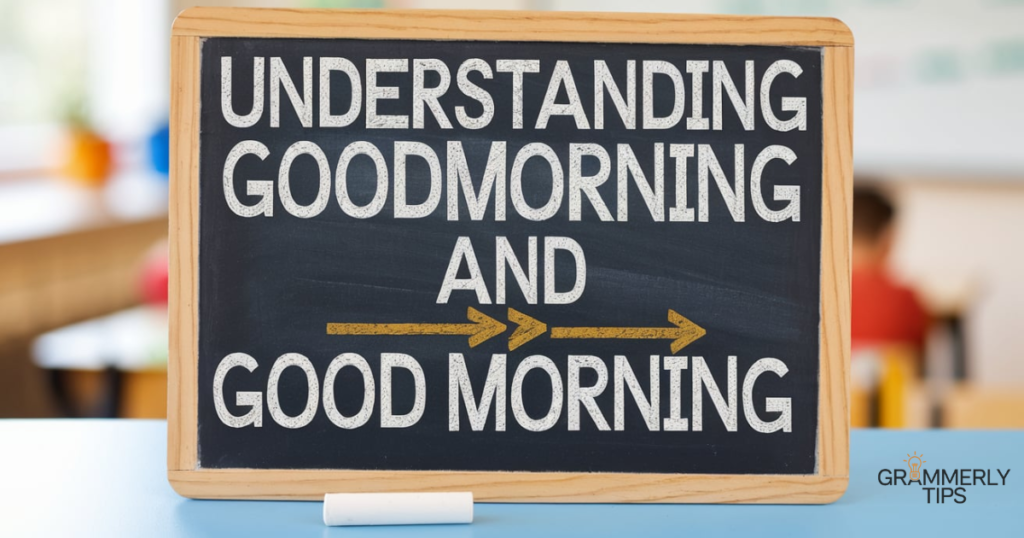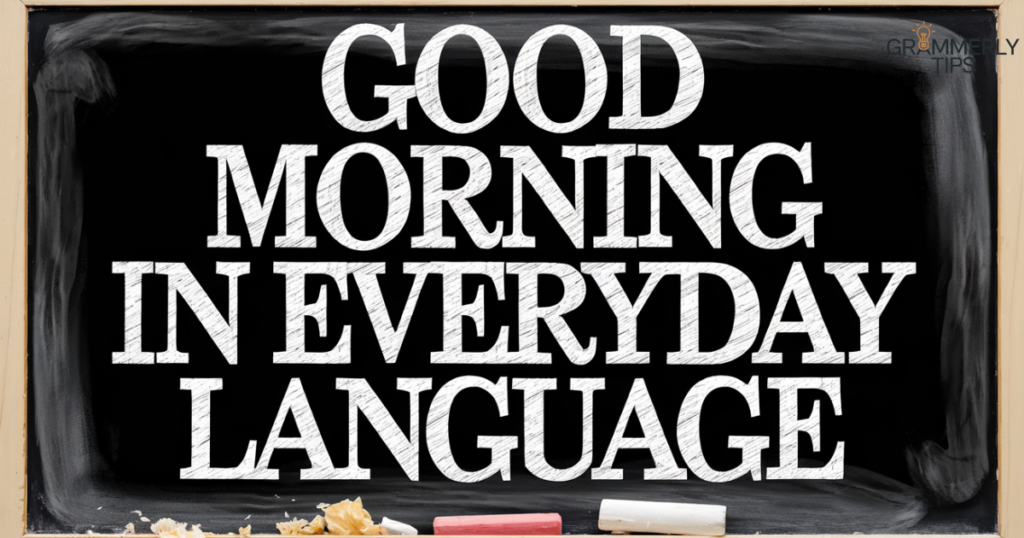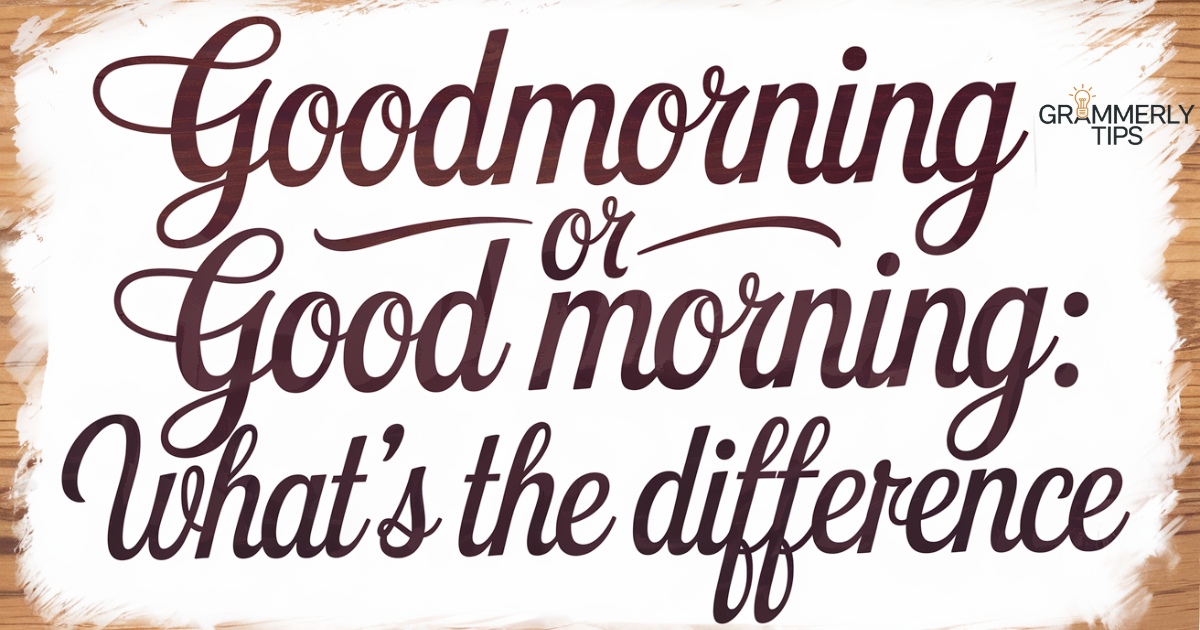Language can be tricky, especially when it comes to spelling and spacing. A common question many people have is whether to write goodmorning or good morning as one word or as two separate words. This confusion often arises in casual text messages, emails, and even social media posts. Knowing which form to use is important for both proper grammar and effective communication.
The correct usage depends on the context. Good morning, written as two words, is a standard greeting used to wish someone well at the start of the day. On the other hand, goodmorning as a single word is incorrect and not accepted in formal English. Let’s explore why this difference matters and how to use these words correctly.
Understanding Goodmorning and Good Morning

Good Morning: Definition and Usage
Good morning is a common greeting used to wish someone well at the start of the day, typically before noon. It expresses a friendly acknowledgment and is often used in both formal and informal contexts.
This greeting sets a positive tone for the day ahead. It is appropriate in most social and professional interactions.
For Example
- Good morning! I hope you had a restful night.
- She smiled and said, ‘Good morning,’ as she entered the office.
You Also Like To Read This: Grammar or Grammer: What’s the Difference?
Goodmorning: Definition and Usage
Goodmorning is an incorrect spelling of the greeting good morning. It combines the two words into one, which is not accepted in standard English. The proper form is always good morning, written as two separate words.
Using goodmorning may be seen as a spelling error in both formal and informal communication.
Side-by-Side Comparison
Here is the side by side comparison of good morning and goodmorning for further clarify the difference which we decide to use:
| Feature | Good Morning | Goodmorning |
| Definition | A standard greeting used in the morning, wishing someone well. | Incorrectly written form of “good morning.” |
| Usage | Commonly used in both formal and informal settings. | Not used in standard English; considered a spelling error. |
| Spelling | Correct spelling with two separate words. | Incorrect spelling as one word. |
| Context | Appropriate for any time before noon when greeting someone. | Not appropriate for any formal or informal context. |
| Example | Good morning, how are you today? | Goodmorning, how are you today? (Incorrect form) |
| Key Difference | Good morning is the correct form, widely accepted in English. | Goodmorning is a misspelling and not used in proper English. |
The side-by-side comparison highlights the key distinction between good morning or goodmorning. Good morning is the grammatically correct form, used widely in both formal and informal contexts to greet someone in the morning.
It is always spelled as two separate words. On the other hand, goodmorning is a common misspelling and should be avoided in any writing. The key difference lies in proper usage and spelling good morning is accepted and standard, while goodmorning is not.
Using “Good Morning“ In Everyday Language

Now we see to illustrate how we use good morning in our every day language:
Formal
Greeting colleagues: Good morning, everyone! I hope you had a great weekend.
Addressing a customer: Good morning, thank you for calling. How can I assist you today?”
Starting a meeting: Good morning, team. Let’s get started with today’s agenda.
Informal
Greeting a friend or family member: “Good morning! How did you sleep last night?
Saying hello to a neighbor: Good morning, Mr. Smith! How’s it going today?
Replying to a text message: Good morning! I’ll be there in 10 minutes.
Additionally
- Leaving a voicemail: Good morning, this is [Your Name]. I’m calling regarding [topic]. Please return my call at your earliest convenience.
- Responding to an email: Good morning, [Recipient’s Name], thank you for your email. I appreciate your prompt response.
- Greeting someone online: Good morning, everyone! Hope you’re having a great day so far.
FAQ: Goodmorning vs. Good Morning
What is the correct way to say good morning?
The correct way to say “good morning” is by writing it as two separate words: good morning. It’s a common and polite greeting used in the morning before noon. Saying it aloud or in writing helps convey a positive start to someone’s day.
Can I write ‘goodmorning’ as one word?
No, goodmorning is a common misspelling and should always be written as good morning. In formal and informal communication, combining the two words into one is not grammatically correct. Always use the two-word version for proper spelling.
Is it okay to use ‘Goodmorning’ in texts or emails?
Using Goodmorning as one word is not acceptable in formal writing, and even in casual texts or emails, it is best avoided. Stick with Good morning, as this is the grammatically correct form. Using the correct version ensures clarity and professionalism.
Why is ‘Good morning’ written as two words?
Good morning is written as two words because good is an adjective describing the noun morning. The phrase is a conventional greeting, and separating the words maintains proper grammatical structure. This two-word form is standard in English.
Will people understand me if I accidentally type ‘goodmorning’?
Most people will understand your meaning if you accidentally type goodmorning, but it may be seen as a spelling mistake. It’s always better to use good morning to avoid confusion and to maintain proper writing standards. Accuracy in language helps build trust.
Are there any exceptions where ‘goodmorning’ is considered correct?
No, there are no exceptions where goodmorning is considered correct in standard English. The proper usage is always good morning, whether in formal or informal contexts. Using goodmorning is a common error that should be avoided.
How can I remember to always write ‘Good morning’ correctly?
One way to remember is to think of good morning as a greeting that consists of two parts, good and morning. Another trick is to always check your writing, especially in emails or messages, before sending. Using grammar-check tools can also help spot mistakes.
Is ‘Good morning’ used differently in other languages?
Yes, in other languages, there are different ways to greet someone in the morning. For example, in Spanish, you say buenos días, and in French, it’s bonjour. Each language has its own cultural nuances and greetings for the morning, though the concept is similar.
Can “Good morning” be used after noon?
Typically, good morning is used before noon as a morning greeting. However, in some casual or social settings, people may still use it as a friendly greeting even after midday, though it’s less common. Once it’s past noon, you might want to switch to good afternoon.
Is it polite to say “Good morning” to strangers?
Yes, saying good morning to strangers is generally considered polite and friendly. It’s a warm, courteous way to acknowledge someone, especially in professional or public settings. It can help establish a positive atmosphere and make interactions more pleasant.
Bonus Tip
When greeting someone with good morning, try to smile and make eye contact to add warmth to your words. It’s a simple yet effective way to brighten someone’s day. A positive attitude combined with this greeting can leave a lasting impression.
Conclusion
In conclusion, understanding the correct way to use good morning is essential for clear communication and proper grammar. Always remember to write it as two separate words, as goodmorning is considered a spelling mistake. Whether you’re greeting colleagues, friends, or strangers, this greeting sets a positive tone for the day.
While it’s acceptable to use good morning in texts and emails, avoid the incorrect form goodmorning. Practicing this simple habit ensures you maintain a polished and professional writing style. Ultimately, using good morning correctly reflects well on you in both casual and formal settings.

Grammerlytips.com, authored by Jame, offers expert tips and insights on mastering grammar, enhancing writing skills, and boosting communication effectiveness.

